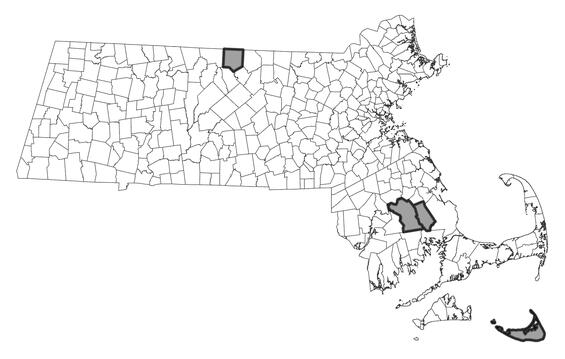- Scientific name: Lycopodiella alopecuroides
- Species of Greatest Conservation Need (MA State Wildlife Action Plan)
- Endangered (MA Endangered Species Act)
Description
Foxtail clubmoss is a perennial, non-flowering plant with tiny (~6 mm long; 0.24 in) triangular leaves covering wiry stems. It is in the clubmoss family (Lycopodiaceae) and is one of three species in Massachusetts commonly called “bog clubmosses” (i.e., genus Lycopodiella). Stems are of two types: horizontal stems, which sprawl along the ground, and upright stems, each of which produces a single spore-bearing structure at the tip, called a strobilus. The strobili are bushy and prominent, 12-20 mm (0.47-0.79 in) in diameter and 20-60 mm (0.79-2.36 in) in height. The resemblance of the strobili to the seed heads of foxtail grasses in the genus Alopecurus gave rise to the species’ Latin name. In the southern part of the range, plants are at least partly evergreen; in Massachusetts, plants die back in winter with the exception of the stem tips, which become packed with starch and persist over winter. Plants reestablish each year from these overwintering stem tips (called turions).
There are several genera and many species of clubmoss in Massachusetts. The bog clubmosses (Lycopodiella) can be distinguished from all other genera based on two characteristics: the upright, strobilus-bearing stems are not branched and the sporophylls (tiny scale-like leaves of the strobilus) are green rather than straw-colored.
Appressed bog clubmoss (L. appressa) and northern bog clubmoss (L. inundata) are the congeners known from Massachusetts. The three bog clubmosses are similar in form and habitat affinities and are often found growing together. The foxtail clubmoss is the only one with arching horizontal stems, which produce roots only at points between the arches where the stem touches the ground. The other species have horizontal stems that grow tightly appressed to the ground and root frequently along their lengths. Further, foxtail clubmoss has coarse teeth along the edges of the leaves on the horizontal stems. The very common and widespread northern bog clubmoss has toothless stem leaves. Appressed bog clubmoss has toothed leaves like foxtail clubmoss, but its leaves are appressed (strongly ascending so they are nearly parallel to the stem), whereas leaves of the foxtail clubmoss spread away from the stem.
Hybrids between bog clubmoss species are frequent, and many of the known locations for foxtail clubmoss have hybrid plants. The hybrids have intermediate characteristics, which can complicate identification.
Life cycle and behavior
Black-fruited woodrush is a perennial species.
Population status
Foxtail clubmoss is listed under the Massachusetts Endangered Species Act as endangered. All listed species are protected from killing, collecting, possessing, or sale and from activities that would destroy habitat and thus directly or indirectly cause mortality or disrupt critical behaviors. The Massachusetts Natural Heritage & Endangered Species Program has 8 records from 3 counties: Nantucket, Plymouth, and Worcester. Five of these records have been observed within the last 25 years.

Distribution in Massachusetts
1999-2024
Based on records in the Natural Heritage Database
Distribution and abundance
Foxtail clubmoss ranges from Maine to Florida on the Atlantic coastal plain and west to Texas along the Gulf Coast. Its range extends inland in the Mississippi River Valley to Arkansas and Tennessee. It is also reported for Cuba and the West Indies.
Habitat
Massachusetts populations of foxtail clubmoss are on wet, acidic sand and peat; areas with a thin accumulation of peat over saturated sand are particularly favorable. Suitable habitat can be natural, as in bogs and sandy pond shores, or artificial, such as borrow pits and similar excavated areas. Foxtail clubmoss is a poor competitor, and documented populations occur in sparsely vegetated areas in full sun. Suitable, but unoccupied habitat is abundant in Massachusetts. Recent discoveries in northern Worcester County, Massachusetts, and coastal Maine, well beyond the historic northern range limit in south-coastal Massachusetts, suggest the possibility for additional new discoveries throughout Massachusetts.
Healthy habitats are vital for supporting native wildlife and plants. Explore habitats and learn about conservation and restoration in Massachusetts.
Threats
The combination of Massachusetts Wetland Protection Act regulations and the Massachusetts Endangered Species Act should provide very good protection for many known populations. However, the propensity of foxtail clubmoss to establish in human-altered habitats such as borrow pits, utility rights-of-way, and cranberry bogs could leave many populations vulnerable to harm. Any activity that changes the hydrology of occupied sites has the potential to harm populations.
Conservation
Landowners and managers of at-risk populations should be informed and shown the locations of populations so they can avoid accidental damage from routine operations and maintenance activities. At sites where natural ecological processes (such as periodic prolonged flooding or erosion) are not sufficient to maintain sparse, low-stature vegetation and produce occasional mineral soil exposures, natural succession is likely to result in the decline and eventual loss of local populations. At these sites, the removal of competing vegetation and applying artificial disturbance commensurate with that which originally created suitable habitat conditions might be effective management.
All active management of rare plant populations (including invasive species removal) is subject to review under the Massachusetts Endangered Species Act and should be planned in close consultation with MassWildlife’s Natural Heritage & Endangered Species Program.
References
Cobb, B., E.J. Farnsworth, and C. Lowe. 2005. Peterson Field Guide to the Ferns of Northeastern and Central North America. Houghton-Mifflin Company, Boston, Massachusetts, USA.
Gilman, A.V. 2004. Lycopodiella alopecuroides (L.) Cranfill (Foxtail Bog-Clubmoss) Conservation and Research Plan for New England. New England Wild Flower Society, Framingham, Massachusetts, USA.
Haines, A. 2001. Discovery of two new Lycopodiella (Lycopodiaceae) in Maine. Rhodora 103: 431–434.
Haines, A. 2003. The Families Huperziaceae and Lycopodiaceae of New England. V. F. Thomas Company, Bowdoin, Maine, USA.
Wagner, W.H., Jr. and J.M. Beitel. 1993. Lycopodiella. Pages 34-37 in Flora of North America Editorial Committee (Editors). Flora of North America North of Mexico. Volume Two: Pteridophytes and Gymnosperms. Oxford University Press, New York, New York, USA.
Contact
| Date published: | May 6, 2025 |
|---|